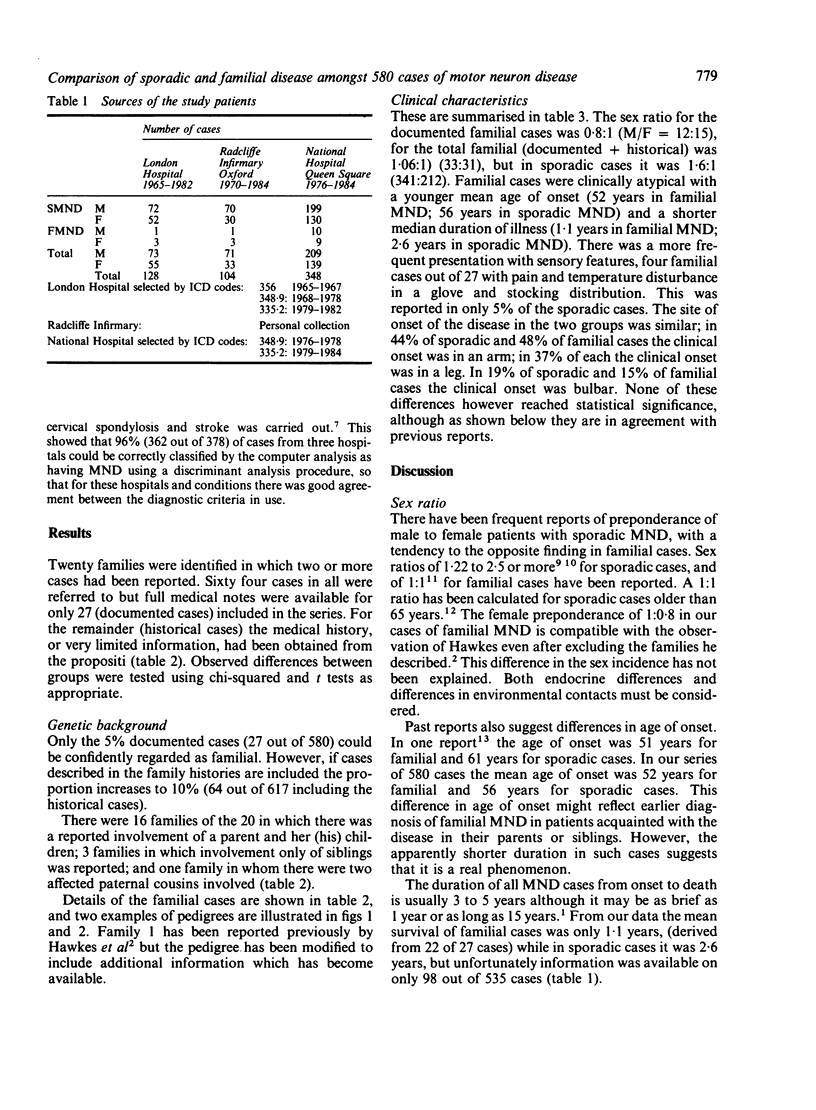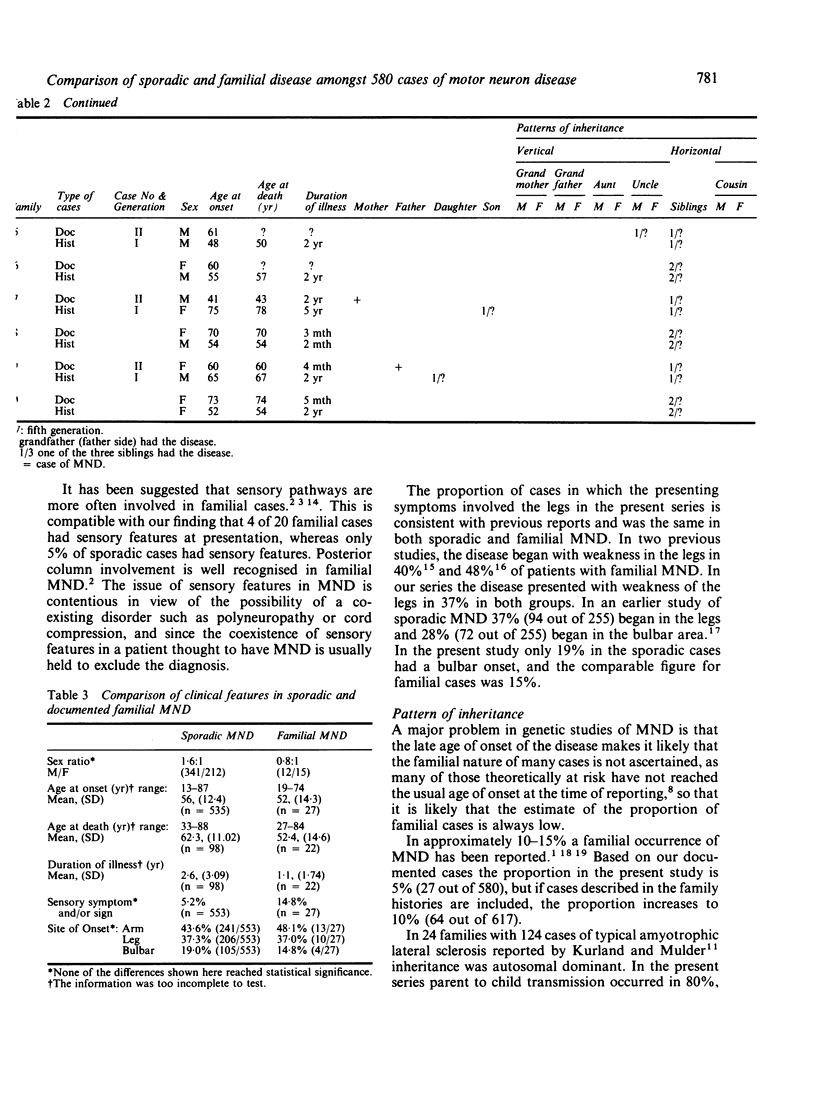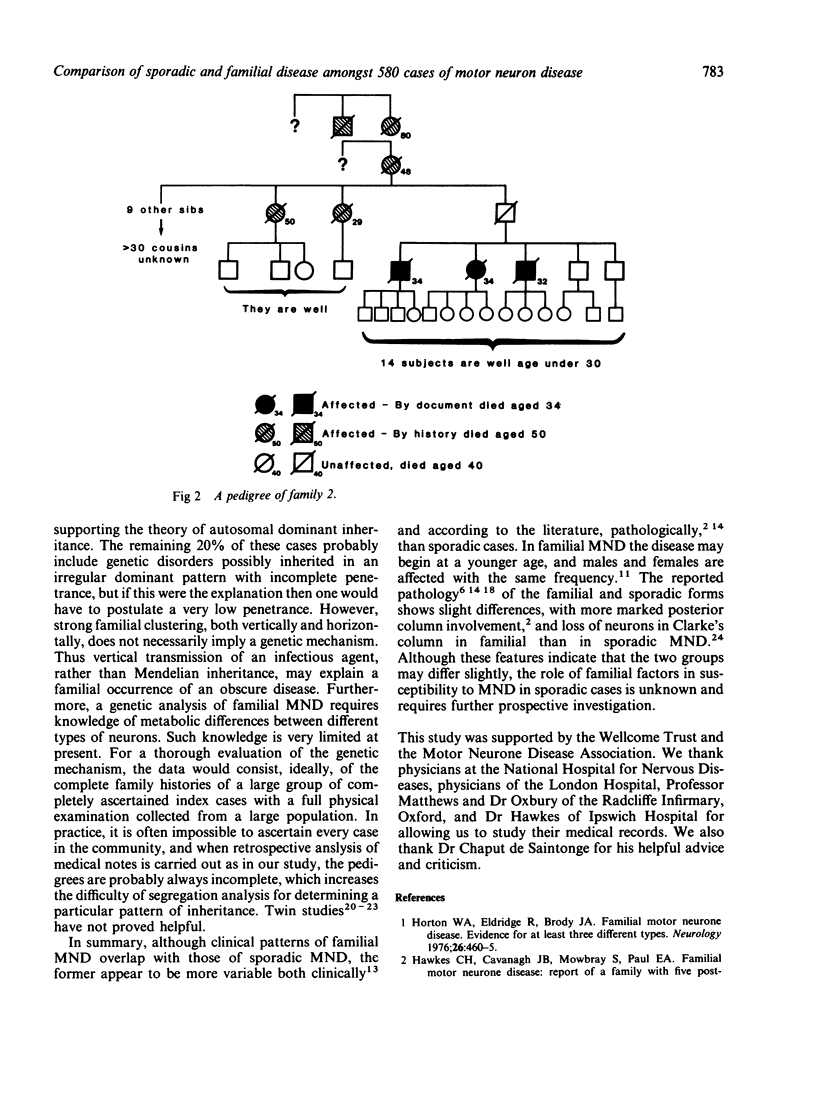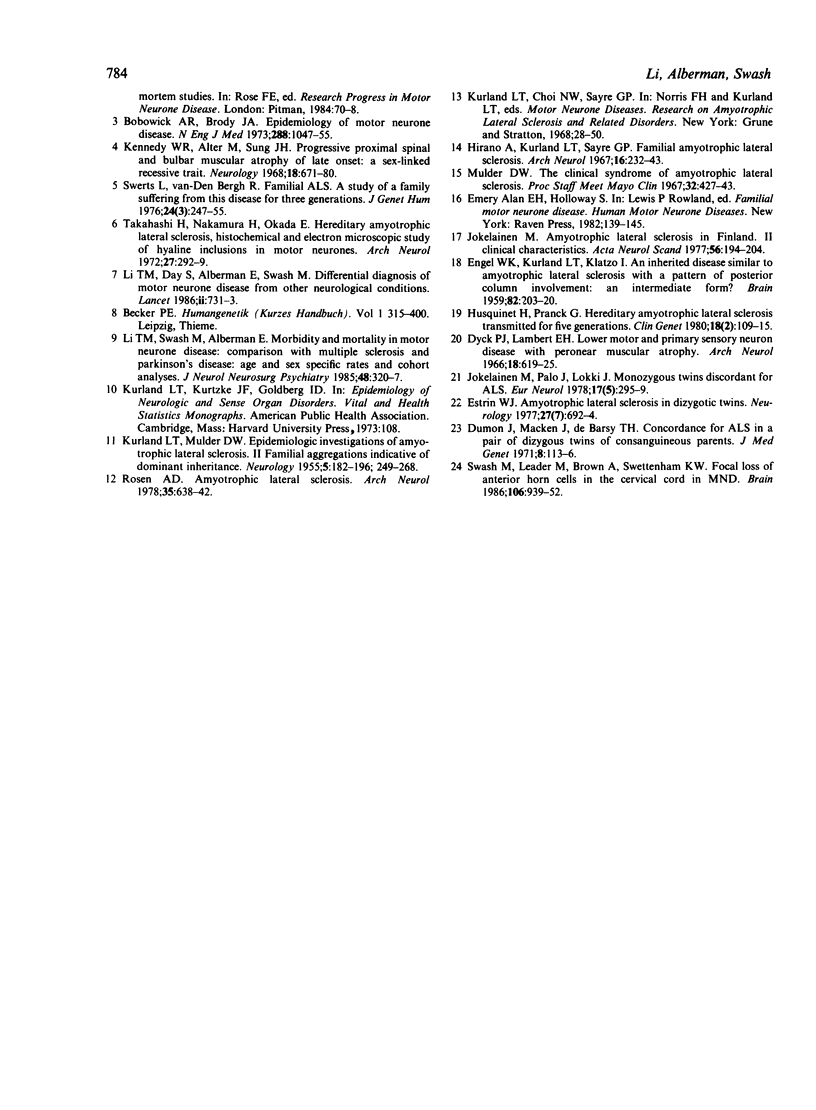Abstract
A review of 580 hospital case notes of patients with motor neuron disease (MND) revealed 20 families in which more than one case had been reported. For 27 of the cases in these families full medical records were available, and a history of a further 37 affected family members were obtained. The cases in these 20 families are termed familial and the remainder sporadic. Parent to child transmission occurred in 16 of the 20 families of the familial cases, suggesting autosomal dominant inheritance. In three families there was involvement of siblings only, and in one family two cousins were affected. The sex ratio for the documented familial case records seen was 0.8:1 (M/F = 12:15), for the total (documented and historical) it was 1.06:1 (33:31), but in sporadic cases it was 1.6:1 (341:212) and more frequent occurrence of sensory features at presentation was reported in the familial cases (15% in the familial cases and 5% in the sporadic cases). However, none of these differences reached statistical significance. Familial cases also differed from sporadic cases in having a younger age of onset (a mean of 52 years in the familial cases compared with 56 years in the sporadic) and in the shorter median reported duration of illness (1.1 year in the familial cases; 2.6 years in the sporadic). However, in only one fifth of sporadic cases was the age at onset and death known, although this was known for 22 of the 27 familial cases, so that the data on survival and age of onset are too incomplete to test formally.
Full text
PDF






Selected References
These references are in PubMed. This may not be the complete list of references from this article.
- Bobowick A. R., Brody J. A. Epidemiology of motor-neuron diseases. N Engl J Med. 1973 May 17;288(20):1047–1055. doi: 10.1056/NEJM197305172882005. [DOI] [PubMed] [Google Scholar]
- Dumon J., Macken J., De Barsy T. Concordance for amyotrophic lateral sclerosis in a pair of dizygous twins of consanguineous parents. J Med Genet. 1971 Mar;8(1):113–116. doi: 10.1136/jmg.8.1.113. [DOI] [PMC free article] [PubMed] [Google Scholar]
- Dyck P. J., Lambert E. H. Lower motor and primary sensory neuron diseases with peroneal muscular atrophy. II. Neurologic, genetic, and electrophysiologic findings in various neuronal degenerations. Arch Neurol. 1968 Jun;18(6):619–625. doi: 10.1001/archneur.1968.00470360041003. [DOI] [PubMed] [Google Scholar]
- ENGEL W. K., KURLAND L. T., KLATZO I. An inherited disease similar to amyotrophic lateral sclerosis with a pattern of posterior column involvement. An intermediate form? Brain. 1959 Jun;82:203–220. doi: 10.1093/brain/82.2.203. [DOI] [PubMed] [Google Scholar]
- Emery A. E., Holloway S. Familial motor neuron diseases. Adv Neurol. 1982;36:139–147. [PubMed] [Google Scholar]
- Estrin W. J. Amyotrophic lateral sclerosis in dizygotic twins. Neurology. 1977 Jul;27(7):692–694. doi: 10.1212/wnl.27.7.692. [DOI] [PubMed] [Google Scholar]
- Hirano A., Kurland L. T., Sayre G. P. Familial amyotrophic lateral sclerosis. A subgroup characterized by posterior and spinocerebellar tract involvement and hyaline inclusions in the anterior horn cells. Arch Neurol. 1967 Mar;16(3):232–243. doi: 10.1001/archneur.1967.00470210008002. [DOI] [PubMed] [Google Scholar]
- Horton W. A., Eldridge R., Brody J. A. Familial motor neuron disease. Evidence for at least three different types. Neurology. 1976 May;26(5):460–465. doi: 10.1212/wnl.26.5.460. [DOI] [PubMed] [Google Scholar]
- Husquinet H., Franck G. Hereditary amyotrophic lateral sclerosis transmitted for five generations. Clin Genet. 1980 Aug;18(2):109–115. doi: 10.1111/j.1399-0004.1980.tb01020.x. [DOI] [PubMed] [Google Scholar]
- Jokelainen M. Amyotrophic lateral sclerosis in Finland. II: Clinical characteristics. Acta Neurol Scand. 1977 Sep;56(3):194–204. doi: 10.1111/j.1600-0404.1977.tb01425.x. [DOI] [PubMed] [Google Scholar]
- KURLAND L. T., MULDER D. W. Epidemiologic investigations of amyotrophic lateral sclerosis. 2. Familial aggregations indicative of dominant inheritance. II. Neurology. 1955 Apr;5(4):249–268. doi: 10.1212/wnl.5.4.249. [DOI] [PubMed] [Google Scholar]
- Kennedy W. R., Alter M., Sung J. H. Progressive proximal spinal and bulbar muscular atrophy of late onset. A sex-linked recessive trait. Neurology. 1968 Jul;18(7):671–680. doi: 10.1212/wnl.18.7.671. [DOI] [PubMed] [Google Scholar]
- Li T. M., Day S. J., Alberman E., Swash M. Differential diagnosis of motoneurone disease from other neurological conditions. Lancet. 1986 Sep 27;2(8509):731–733. [PubMed] [Google Scholar]
- Li T. M., Swash M., Alberman E. Morbidity and mortality in motor neuron disease: comparison with multiple sclerosis and Parkinson's disease: age and sex specific rates and cohort analyses. J Neurol Neurosurg Psychiatry. 1985 Apr;48(4):320–327. doi: 10.1136/jnnp.48.4.320. [DOI] [PMC free article] [PubMed] [Google Scholar]
- MULDER D. W. The clinical syndrome of amyotrophic lateral sclerosis. Proc Staff Meet Mayo Clin. 1957 Aug 21;32(17):427–436. [PubMed] [Google Scholar]
- Rosen A. D. Amyotrophic lateral sclerosis. Clinical features and prognosis. Arch Neurol. 1978 Oct;35(10):638–642. doi: 10.1001/archneur.1978.00500340014003. [DOI] [PubMed] [Google Scholar]
- Swash M., Leader M., Brown A., Swettenham K. W. Focal loss of anterior horn cells in the cervical cord in motor neuron disease. Brain. 1986 Oct;109(Pt 5):939–952. doi: 10.1093/brain/109.5.939. [DOI] [PubMed] [Google Scholar]
- Takahashi K., Nakamura H., Okada E. Hereditary amyotrophic lateral sclerosis. Histochemical and electron microscopic study of hyaline inclusions in motor neurons. Arch Neurol. 1972 Oct;27(4):292–299. doi: 10.1001/archneur.1972.00490160020003. [DOI] [PubMed] [Google Scholar]


